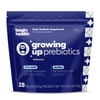Your Cart is Empty
Continue shoppingWhy Parents Are Choosing Prebiotics Over Stool Softeners for Kids
Medically Reviewed by May Zhu, RDN | Published April 16, 2025
share this article

Constipation in kids is incredibly common and incredibly frustrating. While stool softeners have long been the go-to remedy, more and more parents are turning to prebiotics as a gentler, longer-term solution. But why the shift?
Let’s break it down.
Prebiotics vs. Stool Softeners: What’s the Difference?
Stool softeners, like polyethylene glycol (PEG 3350), work by drawing water into the stool to make it easier to pass. While effective in the short term, they don’t address the root cause of constipation and some kids may need them for months, which can worry parents.
Prebiotics, on the other hand, are fibers that feed the beneficial bacteria in your child’s gut. By nourishing a healthier microbiome, prebiotics help support regular digestion and improve stool consistency naturally over time. Think of them as plant food for your kid’s gut garden.
5 Reasons Parents Are Making the Switch
1. Long-Term Gut Health, Not Just Short-Term Relief
Unlike stool softeners, prebiotics support overall digestive health by strengthening the gut microbiome. Studies have shown that kids with constipation often have an imbalance in gut bacteria and prebiotics can help shift things in the right direction.
A randomized controlled trial found that supplementing with prebiotic oligosaccharides improved stool frequency and consistency in constipated children compared to placebo [1].
2. Fewer Side Effects
Stool softeners are generally safe, but long-term use can cause bloating, cramping, or even dependency. Prebiotics, especially those like chicory root inulin or HMOs (Human Milk Oligosaccharides), are naturally found in foods or breast milk and are generally well tolerated.
3. A More Natural Approach
Parents are increasingly looking for solutions that feel closer to nature. Prebiotics are found naturally in kiwis, apples, or berries. For families focused on clean labels and gentle interventions, this matters.
4. Building Healthier Habits Early
Supporting a healthy gut in early childhood doesn’t just help with easier potty times. Research shows the microbiome is tied to immunity, mood, and even long-term metabolic health [2].
Daily prebioticscan become part of a wellness routine, not just a treatment.
5. Easy to Add to a Busy Routine
Modern prebiotic supplements such as Begin Health's Growing Up Prebiotics are tasteless and textureless powders that dissolve easily in water, milk, or yogurt. No mealtime battles or flavor complaints, making adding prebiotics into your little one's day a breeze.
The Bottom Line
If your little one is struggling to go, you’re not alone. But parents are no longer just looking for symptom relief, they’re asking how to build better digestion for life. That’s why prebiotics are quickly becoming the first choice for many families.

Author
May Zhu, RDN
Trending

How to Transition Kids Off Stool Softeners Safely
read now
How to Know If Your Kid Needs a Stool Softener (or Something Else)
read now
Inc. Names Begin Health to Its 2025 List of the Fastest-Growing Private Companies in the Midwest
read now






